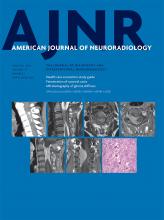Index by author
Saba, L.
- Extracranial VascularYou have accessCT Attenuation Analysis of Carotid Intraplaque HemorrhageL. Saba, M. Francone, P.P. Bassareo, L. Lai, R. Sanfilippo, R. Montisci, J.S. Suri, C.N. De Cecco and G. FaaAmerican Journal of Neuroradiology January 2018, 39 (1) 131-137; DOI: https://doi.org/10.3174/ajnr.A5461
Sanelli, P.C.
- You have accessInfluences for Gender Disparity in Academic NeuroradiologyM. Ahmadi, K. Khurshid, P.C. Sanelli, S. Jalal, T. Chahal, A. Norbash, S. Nicolaou, M. Castillo and F. KhosaAmerican Journal of Neuroradiology January 2018, 39 (1) 18-23; DOI: https://doi.org/10.3174/ajnr.A5443
Sanfilippo, R.
- Extracranial VascularYou have accessCT Attenuation Analysis of Carotid Intraplaque HemorrhageL. Saba, M. Francone, P.P. Bassareo, L. Lai, R. Sanfilippo, R. Montisci, J.S. Suri, C.N. De Cecco and G. FaaAmerican Journal of Neuroradiology January 2018, 39 (1) 131-137; DOI: https://doi.org/10.3174/ajnr.A5461
San Roman, L.
- InterventionalOpen AccessPosttreatment Infarct Volumes when Compared with 24-Hour and 90-Day Clinical Outcomes: Insights from the REVASCAT Randomized Controlled TrialF.S. Al-Ajlan, A.S. Al Sultan, P. Minhas, Z. Assis, M.A. de Miquel, M. Millán, L. San Román, A. Tomassello, A.M. Demchuk, T.G. Jovin, P. Cuadras, A. Dávalos, M. Goyal and B.K. Menon for the REVASCAT InvestigatorsAmerican Journal of Neuroradiology January 2018, 39 (1) 107-110; DOI: https://doi.org/10.3174/ajnr.A5463
Schubert, T.B.
- FELLOWS' JOURNAL CLUBPediatric NeuroimagingYou have accessDeep Brain Nuclei T1 Shortening after Gadobenate Dimeglumine in Children: Influence of Radiation and ChemotherapyS. Kinner, T.B. Schubert, R.J. Bruce, S.L. Rebsamen, C.A. Diamond, S.B. Reeder and H.A. RowleyAmerican Journal of Neuroradiology January 2018, 39 (1) 24-30; DOI: https://doi.org/10.3174/ajnr.A5453
The authors reviewed clinical charts and images of patients 18 years of age or younger with ≥4 gadobenatedimeglumine–enhanced MRIs for 6 years. Seventy-six children (60 unconfounded by treatment, 16 with radiochemotherapy) met the selection criteria. T1 signal intensity ratios for the dentate to pons and globus pallidus to thalamus were calculated and correlated with number of injections, time interval, and therapy. Among the 60 children without radiochemotherapy, only 2 had elevated T1 signal intensity ratios. Twelve of the 16 children with radiochemotherapy showed elevated signal intensity ratios. Statistical analysis demonstrated a significant signal intensity ratio change for the number of injections. Compared with published adult series, children show a similar pattern of T1 hyperintense signal changes of the dentate and globus pallidus after multiple gadobenatedimeglumine injections. The T1 signal changes in children are accelerated by radiochemotherapy.
Seners, P.
- FELLOWS' JOURNAL CLUBAdult BrainYou have accessDo Fluid-Attenuated Inversion Recovery Vascular Hyperintensities Represent Good Collaterals before Reperfusion Therapy?E. Mahdjoub, G. Turc, L. Legrand, J. Benzakoun, M. Edjlali, P. Seners, S. Charron, W. Ben Hassen, O. Naggara, J.-F. Meder, J.-L. Mas, J.-C. Baron and C. OppenheimAmerican Journal of Neuroradiology January 2018, 39 (1) 77-83; DOI: https://doi.org/10.3174/ajnr.A5431
The authors evaluated 244 consecutive patients eligible for reperfusion therapy with MCA stroke and pretreatment MR imaging with both FLAIR and PWI. The FLAIR vascular hyperintensity score was based on ASPECTS, ranging from 0 (no FLAIR vascular hyperintensity) to 7 (FLAIR vascular hyperintensities abutting all ASPECTS cortical areas). The hypoperfusion intensity ratio was defined as the ratio of the time-to-maximum >10-second over time-to-maximum >6-second lesion volumes. The FLAIR vascular hyperintensities were more extensive in patients with good collaterals than those with poor collaterals. The FLAIR vascular hyperintensity score was independently associated with good collaterals. They conclude that the ASPECTS assessment of FLAIR vascular hyperintensities could be used to rapidly identify patients more likely to benefit from reperfusion therapy.
Seo, K.J.
- Head and Neck ImagingYou have accessEffect of an Arm Traction Device on Image Quality and Radiation Exposure during Neck CT: A Prospective StudyY.J. Choi, J.H. Lee, D.H. Yoon, H.J. Kim, K.J. Seo, K.-H. Do and J.H. BaekAmerican Journal of Neuroradiology January 2018, 39 (1) 151-155; DOI: https://doi.org/10.3174/ajnr.A5418
Serulle, Y.
- LETTERYou have accessReply:S.K. Thakur, Y. Serulle, N.P. Miskin, H. Rusinek, J. Golomb and A.E. GeorgeAmerican Journal of Neuroradiology January 2018, 39 (1) E7; DOI: https://doi.org/10.3174/ajnr.A5525
Shah, L.M.
- Adult BrainYou have accessAssociation of Developmental Venous Anomalies with Demyelinating Lesions in Patients with Multiple SclerosisD.M. Rogers, M.E. Peckham, L.M. Shah and R.H. WigginsAmerican Journal of Neuroradiology January 2018, 39 (1) 97-101; DOI: https://doi.org/10.3174/ajnr.A5374
Shah, V.N.
- Spine Imaging and Spine Image-Guided InterventionsYou have accessLong-Term Effectiveness of Direct CT-Guided Aspiration and Fenestration of Symptomatic Lumbar Facet Synovial CystsV.N. Shah, N.D. von Fischer, C.T. Chin, E.L. Yuh, M.R. Amans, W.P. Dillon and C.P. HessAmerican Journal of Neuroradiology January 2018, 39 (1) 193-198; DOI: https://doi.org/10.3174/ajnr.A5428








